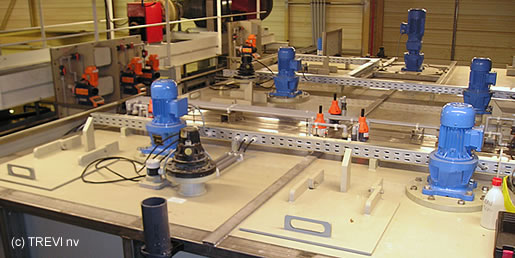Purpose
Metal removal, metal detoxification
Specific removal of zinc (Zn), lead (Pb), arsenic (As), copper (Cu), cadmium (Cd), molybdenum (Mo), tin (Sn), manganese (Mn), chromium (Cr), ...
Principle
A lot of metal hydroxides are poorly soluble in water. This property is used to precipitate heavy metals present in wastewater by adding hydroxides (pH = increase). Every metal hydroxide has a minimum solubility at a certain pH. In order to achieve this optimal pH-value use is usually made of milk of lime (Ca(OH)2) or caustic soda (NaOH). By precipitating metals as a sulfide or by making use of co-precipitation with iron one can obtain even lower concentrations of metal. These reactions can be part of the coagulation-flocculation process in the physico-chemical wastewater treatment.
The formed hydroxide flocks are enlarged with a polymer and gravitational removed in a clarifier or scraped off in a flotation unit. The formed sludge is then dewatered by means of for example a chamber filter press or centrifuge and disposed for external treatment.
Eventually the water has to be neutralised again to comply with the effluent regulations afterwards.
Scheme
Applications
The waste water originating from industries such as metal surface treatment or contaminated storm water from the storage of scrap metal often contains high concentrations of multiple heavy metals. Many heavy metals are carcinogenic or toxic, both to man and the environment, and for that reason must be removed from the waste water. Well-known examples of toxic heavy metals are lead, mercury, arsenic and chromium.
Example of a realisation

Physicochemical treatment: removal of metals
Operational costs
Besides the investment in the purification equipment there are also operational costs during the physicochemical removal of heavy metals from wastewater. The main operational costs in this case are the consumption of chemicals and the removal of the physicochemical sludge.
Approach Trevi
Trevi always checks whether the costs for physicochemical wastewater treatment could be optimised by at-source measures or by side-stream treatment of certain waste waters. The most efficient choice and dose of chemicals is determined based on jar tests, keeping a minimal chemical consumption and sludge production in mind.
.jpg)